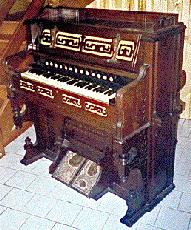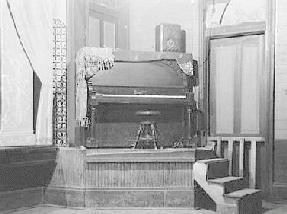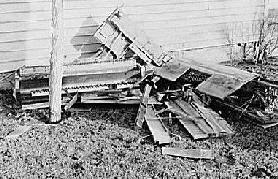
So where did it come from? Where is it going? And why?
The lore is that the Cape Breton style of fiddling is closer to the old Highland Scots style than anything played in Scotland today. As the story goes, refugees from the Highland Clearances came to Cape Breton without their fiddles but soon set to making them.
The original fiddlers of Cape Breton played
accompanied only by their own stamping foot or feet,
this was about the way it was till about the 1900's.

The first instrument used for accompaniament was the parlor reed organ. In the late 1880's to early 1900's these were the home instrument of choice for young ladies. Marie MacLellan mentions that he father, fiddler Big Ronald, showed her how to accompany him with the reed organ.
The old organ style is said to have been your basic oom-pah chording - certainly the quick dense syncopation of today's piano players could not be done on the reed organ.
By the turn of the century (1900), Canada was producing some really good upright pianos, and the reed organ became last week's fish and went out of fashion.
It is difficult to say (or perhaps it is just the wrong question to ask) who originated the Cape Breton style of accompaniament. Certainly today's style is the synergy of many player over the last century.
Probably the earliest recording of a Cape Breton player was not by a Caper at all but by the Irishman Dan Sullivan, who was living in Boston at the time. He was a flamboyant dance band leader who recorded for Columbia in 1928 with Big Dan Hugie MacEachron and Charlie MacKinnon on fiddles.
Also in the late 20's or early 30's Betty Maillet played a recognizable CB style, introducing hints of syncopation and adding VI chords on the Decca recording of The Marchioness of Tu Lybardine by Alick Gillis and his Inverness Seranaders. This can be heard in part on the Tracey Dares video "A Chording to the Tunes", where I took a lot of this info from.
Bess Riddell MacDonald played piano on the Celtic 78 "Braes o' Mar Medley" with Angus Allan Gillis and Dan J Campbell fiddling.
Margaret MacPhee added melody fragments and block voicings recorded on "Stratspey and Reel" with Johhny Wilmot (fiddle) and Tommy Basker (harmonica). Did the harmonica harken back to the reed organ days?
Mary Jesse MacDonald, who recorded with Winston Scotty Fitzgerald, gave us the now familiar walking bass line, chromatic bass runs, and the jazz chords that some players all these years later still criticize as inappropriate.
Marie MacLellan was (and is) known for her rock solid timing and her expressive dance rhythms.
Maybelle Chisholm is the queen of flamboyant syncopations and
glissandos.

Through these early masters, and the work done by others then,
now, and between then and now, we arrive at the exciting style
of playing now known as the Cape Breton style. Of course, it is
not one style but many - each player has their own slant on it.
But we instantly recognize that that swinging, rocking, driving,
fountain of forward motion that is the Cape Breton piano line
clearly delineates this music from your Irish jig.

In the 1980s and 90s yet another trend has arisen, and that is the almost universal use of the electric or digital piano in place of the upright. When I first learned this I was shocked, since most folk traditions have an almost phobic attitude toward anything electric. But a week in Inverness County got me informed. A couple of things are in play there.
First, most uprights in Cape Breton are over 50 years
old. Bad things happen over time to pianos like any other complex organic
object. The image of an old Amherst upright sitting to the side of
the parish hall stage while a piano player pounds her Roland FP-1
is fixed in my mind. Those old verticals are for the most part in
very poor shape.

Certainly when heading out to a céilidh, the player can't be sure of the state of the instrument she will find. That it won't be in tune is almost a given. That it will handle like a Chevy with worn out shocks on a gravel road is likely. Might sound like that too.
So you haul along your digital. You'll get good sound for the purpose (this ain't no classical concert, boy!) and you know it will be in tune and that it will play the way you're used to. You can get a good one for $1000-$2000 CDN, and you can haul it around in a station wagon. Cheaper, easier to move, easier to maintain, and far more reliable - it's not so hard to see after all why the digital is the choice of today.
Which doesn't mean most players wouldn't have a clear clean ball if they found a top quality grand in perfect condition, tune and regulation at the next céilidh!
(Much of the information about early recordings is from Tracey Dares' instructional video "A Chording to the Tunes". Thanks!)